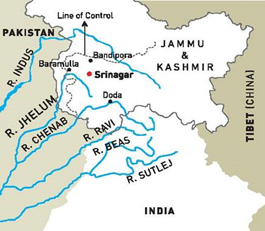

Context
As India falls under a strategic location between the Mountains to the North and Ocean in the South, it tends to hold the flow of several Rivers from its territory to other neighboring countries.
Let us trace important rivers shared by India with its Neighbour countries.
The river web in South Asia
- Perennial rivers have shaped the history, politics, culture, and economy of South Asia for several centuries.
- Several of these perennial South Asian rivers have transboundary basins and watercourses.
- India, Pakistan, Bangladesh, Bhutan, Nepal, and Afghanistan share major rivers among them.
- Indus basin (consisting of the Indus, Ravi, Beas, Sutlej, Jhelum, and Chenab rivers) inter-links India, Pakistan, and China.
- The Brahmaputra and the Ganges basins inter-link China with India, Nepal, Bangladesh, and Bhutan.
- The Kosi, Gandaki, and Mahakali rivers join Nepal with India.
- Major rivers shared between India and Bangladesh are the Brahmaputra, Ganges, and Teesta.

India’s Water sharing
India- Bangladesh:
- India and Bangladesh share 54 rivers.
- India holds the highest number of rivers flowing from India to the Bay of Bengal region via Bangladesh.

- The Ganga: The Ganges in (Bangladesh: Padma) is a trans-boundary river of Asia that flows through India and Bangladesh.
- It flows south and east through the Gangetic plainof North India, receiving the right-bank tributary, the Yamuna, which also rises in the western Indian Himalayas, and several left-bank tributaries from Nepal that account for the bulk of its flow.
- Teesta begins its journey in Sikkim and flows through north Bengal before entering Bangladesh.
- Feni flows 135 km south of Tripura capital Agartala. In a total catchment area of 1,147 square km of the river, 535 square km falls in India and the rest in Bangladesh.
- The other major rivers include Bramhaputra, Meghna, Surma, Jamuna, Kushiyara, Barak, etc.
|
Kushiyara River
|
India-Pakistan:
- The water of River Indus and other west-flowing rivers from India were the issues between India and Pakistan since Independence.
- Indusis a Trans-boundary river of Asia and a trans-Himalayan river of South and Central Asia.
- The river rises in Western Tibet, flows northwest through the disputed region of Kashmir, and flows south-by-southwest through Pakistan, before emptying into the Arabian Sea near the port city of Karachi.
- Other major rivers are Sutlej, Chenab, Jhelum, Beas, Ravi, etc.
India- Nepal:
-
- The Kosi and Gandak are one of the major rivers from Nepal entering India.
- Other Rivers include Rapti, Narayani, kali, etc.
- The Rivers entering India via Nepal are mostly originated from the Tibetan plateau and Himalayan ranges.

India-China:
- The most disputed river in India-China region is the Brahmaputra, which is also known as the Yarlung Tsangpo in Tibet.
- It gets originated in the Manasarovar Lake region, near Mount Kailash, on the northern side of the Himalayas in Burang County of Tibet.
- The river drains the Himalayas east of the Indo-Nepal border, a south-central portion of the Tibetan plateau above the Ganga basin, the south-eastern portion of Tibet, the Patkai hills, the northern slopes of the Meghalaya hills, the Assam plains, and the northern portion of Bangladesh.
|
Important Treaties
|


